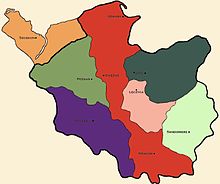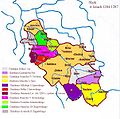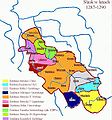Duchy of Silesia
Duchy of Silesia | |||||||||||||||||||
|---|---|---|---|---|---|---|---|---|---|---|---|---|---|---|---|---|---|---|---|
| 1138–1335 | |||||||||||||||||||
Established | 1138 | ||||||||||||||||||
| 1146 | |||||||||||||||||||
• Racibórz split off | 1172 | ||||||||||||||||||
• Opole split off | 1172 | ||||||||||||||||||
• Legnica split off | 1248 | ||||||||||||||||||
| 1335 | |||||||||||||||||||
| 1348 | |||||||||||||||||||
| |||||||||||||||||||
The Duchy of Silesia (
Geography
During the time of its establishment, the Silesian lands covered the basin of the upper and middle Oder river. In the south the Sudetes mountain range up to the Moravian Gate formed the border with the lands of Bohemia - including Kłodzko Land - and Moravia. After a more than century-long struggle, the boundary had just been determined by an 1137 agreement with the Bohemian duke Soběslav I. In the west Lower Silesia bordered on the German March of Lusatia (later Lower Lusatia) and the former Milceni lands around Bautzen (later Upper Lusatia) with the boundary running along the Bóbr and Kwisa rivers. Silesia was limited by the Polish provinces of Greater Poland in the north and the Seniorate Province of Lesser Poland in the east, separated by the Przemsza and Biała rivers.
The boundaries varied slightly in the following decades: at least when the duchy was re-established for the sons of
History

As the Silesian Province (
The testament however failed to prevent a violent inheritance conflict between Władysław and his younger half-brothers, who allied against him. After his failed bid to take control of
With support from Emperor
- Władysław's eldest son, Bolesław I the Tall, received Lower Silesia with Wrocław as his residence; therefore his estates are sometimes already referred to as Duchy of Wrocław.
- The second son, Mieszko I Tanglefoot, received a far smaller part in Upper Silesia and took his residence at Racibórz; this resulted in the creation of the Duchy of Racibórz. In view of his disadvantage, the Polish High Duke Casimir II the Just ceded him further Lesser Polish territories in 1177 (see above).
After a revolt by Bolesław's eldest son,
Bolesław I died in the same year and was succeeded by his only surviving son
Henry II in 1239 had to resign the regency of Upper Silesia in favour of his cousin
- Bolesław II himself took his residence in the west at Konrad. Soon after he sold Lubusz to the Brandenburg margraves, who finally gained a foothold beyond the Oder to establish the Neumark region. In 1251 Konrad, actually elected Bishop of Passau, forced Bolesław to cede the Duchy of Głogówto him.
- The residence of Wrocław fell to his younger brothers Henry III the White and Władysław, thereby establishing the Duchy of Wrocław proper.
The subdivision of the Silesian duchies increased over the following generations and accompanied the
Silesia was incorporated into the
Dukes

- Władysław the Exile (1138–1146), progenitor of the Silesian Piasts, also High Duke of Poland, deposed
- Bolesław the Curly (1146–1163), stepbrother
- Bolesław I the Tall, eldest son of Władysław, re-installed (1163–1201)
- Henry I the Bearded(1201–1238), son, also High Duke of Poland from 1232
- Henry II the Pious (1238–1241), son, also High Duke of Poland, killed in Battle of Legnica
- Bolesław II the Bald (1241–1248), son, became Duke of Legnicain 1248 partition
- Henry III the White (1248–1266), brother, jointly with
- Prince-Archbishop of Salzburgfrom 1265
- Henry IV Probus(1266–1290), son of Henry III, Duke of Wrocław from 1270, also High Duke of Poland from 1288, no issue
- Henry V the Fat(1290–1296), son of Bolesław II, Duke of Legnica since 1278
- Henry VI the Good (1296–1335), second son, under tutelage of:
- Bolko I the Strict (1296–1301), son of Bolesław II
- King Wenceslaus II of Bohemia (1301–1305)
- Bolesław III the Generous (1305–1311), eldest son of Henry V, Duke of Legnica since 1296
As Henry VI left no male heirs, his lands were inherited by King John of Bohemia.
Maps
The following maps illustrate continuing fragemtarization of the Duchy of Silesia, and shifting borders of the individual smaller duchies.
-
1248–1249
-
1249–1273
-
1273–1277
-
1277–1278
-
1278–1281
-
1281–1284
-
1284–1287
-
1287–1290
-
1290–1291
-
1294–1296
-
1296–1301
-
1306–1309
-
1309–1311
-
1312–1317
-
1317–1321
-
1322–1331
Aftermath
After the inheritance of Bohemia by the
References
- Hugo Weczerka: ISBN 3-520-31601-3, S. XXXIV–XXXVII sowie Stammtafel auf p. 590.
- Rudolf Žáček: Dějiny Slezska v datech. Praha 2004, ISBN 80-7277-172-8, S. 444.
- Ulrich Schmilewski: Oppeln, Herzöge v. In: ISBN 3-428-00200-8, p. 558 f.
- Historia Narodu Śląskiego. Prawdziwe dzieje ziem śląskich od średniowiecza do progu trzeciego tysiąclecia (History of Silesian Nation. True history of Silesian lands from the Middle Ages to the threshold of the third Millennium), Zabrze 2003 ISBN 83-919589-0-6.




















